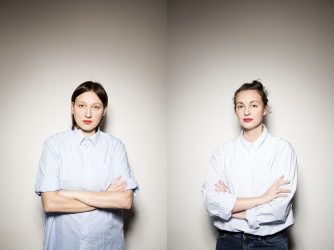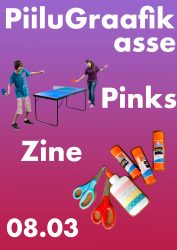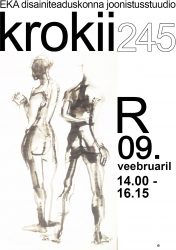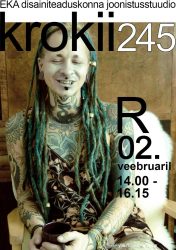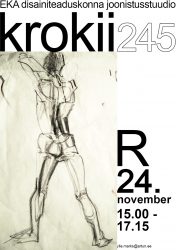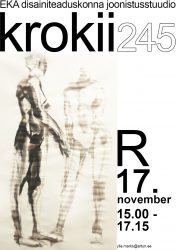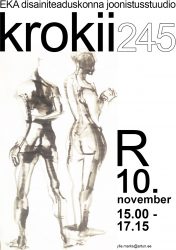Töötoad
06.08.2018 — 11.08.2018
Summer Academy: The Anatomy of Couture
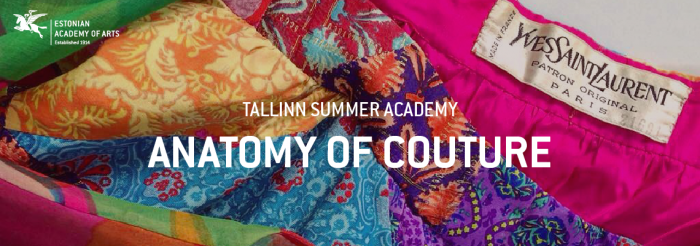 Dates: 6-11 August 2018
Dates: 6-11 August 2018
Volume: 6 days, 3 ECTS
Location: Tallinn City Museum, Vene Str 17
Number of participants: max 22
Cost: FREE (Please note that this course is meant for higher education students only.)
Registration deadline: 6th of May
Students applying for a slot in this workshop are asked to submit a CV and cover letter describing why they wish to participate and whether they have any old article of clothing to bring with them to Estonia. The cover letter should also reveal why they are interested in restoring textiles and haute couture.
Aim of the course:
- bring a disappearing specialized manual skill to Estonia and teach it to Estonian and international students
- restore articles of clothing in the collection of some Estonian museum and thereby contribute to the preservation of an exhibit item with historical value.
Course content:
The course provides practical and theoretical knowledge of how to restore old clothing – selection of fabrics, stitches and seams, treatment of the material, how different materials age, how to care for and restore different fabrics. In the course of the workshop, students will learn about the internal structure of haute couture clothing, allowing them to later create period-specific silhouettes or re-interpretations of them – pattern solutions for textiles, materials. The course will provide knowledge and skills that can be used to get closer to the secrets of high fashion. All of the participants in the course will be able to restore a part of dresses brought in by the lecturer.
The course teaches handicraft skills that have become a rarity, something highly sought-after among professionals. ˇFewer and fewer people practise these skills in a world dominated by modern fashions. Today clothing made 40, 50, even 100 years ago are held in high regard, as they involved the use of original patterns, hand stitching, high-quality tailoring. To this point, the creation of such clothing have remained shrouded in arcane mystery – they seem easy to imitate at first glance but it is impossible to achieve the right effect without knowing what is going on “under the dress.”
The course is mainly meant for fashion design, theatre design, restoration and design students.
More information and link to registration: https://www.artun.ee/summeracademy/the-anatomy-of-couture/
Summer Academy: The Anatomy of Couture
Esmaspäev 06 august, 2018 — Laupäev 11 august, 2018
 Dates: 6-11 August 2018
Dates: 6-11 August 2018
Volume: 6 days, 3 ECTS
Location: Tallinn City Museum, Vene Str 17
Number of participants: max 22
Cost: FREE (Please note that this course is meant for higher education students only.)
Registration deadline: 6th of May
Students applying for a slot in this workshop are asked to submit a CV and cover letter describing why they wish to participate and whether they have any old article of clothing to bring with them to Estonia. The cover letter should also reveal why they are interested in restoring textiles and haute couture.
Aim of the course:
- bring a disappearing specialized manual skill to Estonia and teach it to Estonian and international students
- restore articles of clothing in the collection of some Estonian museum and thereby contribute to the preservation of an exhibit item with historical value.
Course content:
The course provides practical and theoretical knowledge of how to restore old clothing – selection of fabrics, stitches and seams, treatment of the material, how different materials age, how to care for and restore different fabrics. In the course of the workshop, students will learn about the internal structure of haute couture clothing, allowing them to later create period-specific silhouettes or re-interpretations of them – pattern solutions for textiles, materials. The course will provide knowledge and skills that can be used to get closer to the secrets of high fashion. All of the participants in the course will be able to restore a part of dresses brought in by the lecturer.
The course teaches handicraft skills that have become a rarity, something highly sought-after among professionals. ˇFewer and fewer people practise these skills in a world dominated by modern fashions. Today clothing made 40, 50, even 100 years ago are held in high regard, as they involved the use of original patterns, hand stitching, high-quality tailoring. To this point, the creation of such clothing have remained shrouded in arcane mystery – they seem easy to imitate at first glance but it is impossible to achieve the right effect without knowing what is going on “under the dress.”
The course is mainly meant for fashion design, theatre design, restoration and design students.
More information and link to registration: https://www.artun.ee/summeracademy/the-anatomy-of-couture/
20.08.2018 — 25.08.2018
Summer Academy: Wood and Design
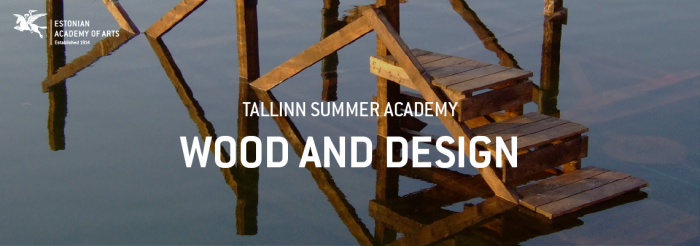
Dates: 20–25 August 2018
Volume: 6 days, 3 ECTS
Location: Loodi Manor, Viljandi, Estonia
Number of participants: max 22
Cost: FREE (Please note that this course is meant for higher education students only)
Registration deadline: 6th of May
In addition to the general admissions requirements, candidates are expected to submit a letter of intent describing their interest in attending the workshop, and a PDF portfolio including documentation of at least one project relevant to the use and/or attributes of wood.
This 6-day workshop Wood and Design in the lush woodlands of Viljandi, Estonia, focuses on the design aesthetics, ecology, and sustainability of wood. Exploring themateri al properties of wood through its use in design, the workshop invites participants to build a set of functional wooden objects for outdoor living with the simplest of means. Participants will utilise wood, as a naturally-occurring renewable material, in two forms: solid slab and left-over scraps from local lumber mills. The workshop is therefore not only community-inspired, with materials sourced or found locally, but also meets the ever-growing need to reclaime and recycle waste wood.
Level:
2nd and 3rd year BA students and MA students in Interior Architecture, Furniture Design, or the equivalent.
More information and link to registration: https://www.artun.ee/summeracademy/wood-and-design/
Summer Academy: Wood and Design
Esmaspäev 20 august, 2018 — Laupäev 25 august, 2018

Dates: 20–25 August 2018
Volume: 6 days, 3 ECTS
Location: Loodi Manor, Viljandi, Estonia
Number of participants: max 22
Cost: FREE (Please note that this course is meant for higher education students only)
Registration deadline: 6th of May
In addition to the general admissions requirements, candidates are expected to submit a letter of intent describing their interest in attending the workshop, and a PDF portfolio including documentation of at least one project relevant to the use and/or attributes of wood.
This 6-day workshop Wood and Design in the lush woodlands of Viljandi, Estonia, focuses on the design aesthetics, ecology, and sustainability of wood. Exploring themateri al properties of wood through its use in design, the workshop invites participants to build a set of functional wooden objects for outdoor living with the simplest of means. Participants will utilise wood, as a naturally-occurring renewable material, in two forms: solid slab and left-over scraps from local lumber mills. The workshop is therefore not only community-inspired, with materials sourced or found locally, but also meets the ever-growing need to reclaime and recycle waste wood.
Level:
2nd and 3rd year BA students and MA students in Interior Architecture, Furniture Design, or the equivalent.
More information and link to registration: https://www.artun.ee/summeracademy/wood-and-design/
20.08.2018 — 24.08.2018
Summer Academy: Numbers and Cognition in the Urban Environment
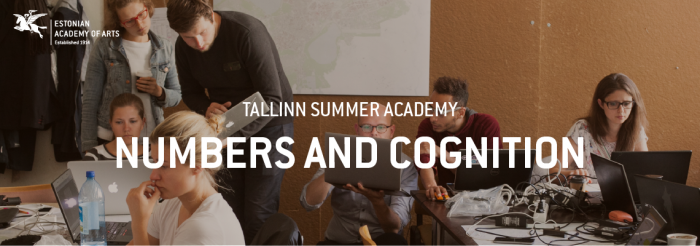
Dates: 20–24 August 2018
Volume: 40 hours, 3 ECTS
Location: Department of Architecture at the Estonian Academy of Arts, Pikk tn 20, 3rd floor, Tallinn
Number of participants: max 25
Cost: FREE (Please note that this course is meant for higher education students only)
Registration deadline: 6th of May
In case of high volume of applications, prospective participants are asked to write an essay one A4-format page in length (approximately 250 words).
Content of the course
This workshop is structured on architecture, numbers and cognition with the focus mainly on public space. Two broader topics pervade the workshop. One of them is more physical, involving translating the world into parameters, and the other is mapping social activities. The broad goal is to find connections between the two sets of topics. The environment around us consists of a number of physically countable and measurable parameters, which we can use to describe it (width of a carriageway, location of a cafe). Which parameters are the best for describing or designing the world? As another important topic, we will map the movements or activities of human masses, using photo and image analysis and Wi-Fi positioning to this end. When, why and where are people moving and how long do they stop – this is an important set of topics, because the quality of space is largely dependent on the presence of people. The participants in the summer academy course will be challenged to find relationships between the physical world and human activity. It will be important to find a means and method for measuring and documenting the environment. Cognition referred to in the course name refers to experience that can be used in future to make decisions to design and re-design space. Ideally, we envision the participants who complete the academy to be capable of imagining and perceiving the implications of 1,000 people or 100 cars passing a point.
Picking key parameters (properties) from this environment has long received attention from urbanism scholars: William H. Whyte, who attempted to trace patterns of use of public space, or Kevin Lynch, who tried to find the mental model people use to understand a city.
The late 20th century brought a rise in computing power, which has resulted in change in the accuracy and use of many calculations. In the past, it was not conceivable to calculate trajectories from one building to another manually, but it is now possible. Alongside this trend, a completely new field has arisen: various kinds of simulations. Simulations make it possible to model traffic, pedestrians or both at the same time. Gathering data has become more intensive with a focus moving from gathering qualitative data to collecting quantitative data. A large part of the summer school involves field observations, which helps instil intuition in participants as to what a given indicator means. This will also give them a clearer understanding of the computational processes and outcomes and they will be able to rationally assess the outcomes of some simulation or facts presented to them.
Participants will become well-versed in methods and means for quantitatively and qualitatively documenting the street-level space, which can in turn later be used for analysis of other places. The participant will also receive an overview of and access to software used in the framework of the workshop. At the end of the summer school, all of the data that was gathered will be made public to allow third parties to use them in their projects – for example, to plan more fluid, safer traffic conditions.
More information and link to registration: https://www.artun.ee/summeracademy/numbers-and-cognition/
Summer Academy: Numbers and Cognition in the Urban Environment
Esmaspäev 20 august, 2018 — Reede 24 august, 2018

Dates: 20–24 August 2018
Volume: 40 hours, 3 ECTS
Location: Department of Architecture at the Estonian Academy of Arts, Pikk tn 20, 3rd floor, Tallinn
Number of participants: max 25
Cost: FREE (Please note that this course is meant for higher education students only)
Registration deadline: 6th of May
In case of high volume of applications, prospective participants are asked to write an essay one A4-format page in length (approximately 250 words).
Content of the course
This workshop is structured on architecture, numbers and cognition with the focus mainly on public space. Two broader topics pervade the workshop. One of them is more physical, involving translating the world into parameters, and the other is mapping social activities. The broad goal is to find connections between the two sets of topics. The environment around us consists of a number of physically countable and measurable parameters, which we can use to describe it (width of a carriageway, location of a cafe). Which parameters are the best for describing or designing the world? As another important topic, we will map the movements or activities of human masses, using photo and image analysis and Wi-Fi positioning to this end. When, why and where are people moving and how long do they stop – this is an important set of topics, because the quality of space is largely dependent on the presence of people. The participants in the summer academy course will be challenged to find relationships between the physical world and human activity. It will be important to find a means and method for measuring and documenting the environment. Cognition referred to in the course name refers to experience that can be used in future to make decisions to design and re-design space. Ideally, we envision the participants who complete the academy to be capable of imagining and perceiving the implications of 1,000 people or 100 cars passing a point.
Picking key parameters (properties) from this environment has long received attention from urbanism scholars: William H. Whyte, who attempted to trace patterns of use of public space, or Kevin Lynch, who tried to find the mental model people use to understand a city.
The late 20th century brought a rise in computing power, which has resulted in change in the accuracy and use of many calculations. In the past, it was not conceivable to calculate trajectories from one building to another manually, but it is now possible. Alongside this trend, a completely new field has arisen: various kinds of simulations. Simulations make it possible to model traffic, pedestrians or both at the same time. Gathering data has become more intensive with a focus moving from gathering qualitative data to collecting quantitative data. A large part of the summer school involves field observations, which helps instil intuition in participants as to what a given indicator means. This will also give them a clearer understanding of the computational processes and outcomes and they will be able to rationally assess the outcomes of some simulation or facts presented to them.
Participants will become well-versed in methods and means for quantitatively and qualitatively documenting the street-level space, which can in turn later be used for analysis of other places. The participant will also receive an overview of and access to software used in the framework of the workshop. At the end of the summer school, all of the data that was gathered will be made public to allow third parties to use them in their projects – for example, to plan more fluid, safer traffic conditions.
More information and link to registration: https://www.artun.ee/summeracademy/numbers-and-cognition/
13.03.2018
Kunstnike Linda ja Daniela Dostálková avalik loeng “The Roles Belong Together”
Teisipäeval, 13. märtsil kell 17.30 tutvustavad kunstnikud Linda ja Daniela Dostálková Eesti Kunstiakadeemias oma erinevaid praktikaid ja loomingut. Avalik loeng on tasuta ning toimub Estonia pst 7 neljandal korrusel ruumis 410 (GD stuudioruum).
Samal nädalal viivad õed Dostálkovád läbi töötoa fotograafia ja graafilise disaini tudengitele. Dostálkovád tegelevad oma praktikas sootsiumi ja kaasaegse kunsti kriitilise mõtestamisega ning kutsuvad end näitusetegijateks. Nende üks märkimisväärsemaid projekte on 2016. aastast alates toiminud Institutsionaalse Homöopaatia Hübriidne Sotsiaalse Kunsti Agentuur, mis propageerib erinevate institutsioonide teineteisemõistmist. www.dostalkova.com
Artists Linda and Daniela Dostálková will discuss their different practices and projects next Tuesday, March 13th at 5.30PM at The Estonian Academy of Arts at Estonia pst 7 on the fourth floor room 410 (GD studio room). Artist Talk The Roles Belong Together is organised by Photography and Graphic Design departments.
The work of Daniela&Linda Dostalkova deals with concept of the autonomous hybrid social ‘art practice’—blurring the lines between disciplines, challenges accepted distinctions, in questioning of identity. Since 2016 they are providing an alternative service in terms of para-agency Institutional Homeopathy©. They trace unexpected articulations of alternative/commodified forms of organizations that are based in the art world and its institutional structures; understanding social phenomena, objects, things, and concepts and the fluidity of boundaries between them. Daniela&Linda position themselves as artists, curators, co-authors and commissioners at the same time, aiming to achieve a complex statement delivered to the viewer. Both sisters studied new media at the Academy of Fine Arts in Warsaw (PL) at professor Grzegorz Kowalski, the pioneer of Open Form. Daniela graduated at Photography department at University of J.E. Purkyně (CZ). Linda was the researcher at Jan van Eyck Academy 2015/16 (NL). Graduated from Werkplaats Typografie (NL) and Scenography at the Academy of Music and Performing Arts (CZ). She was head of the department ‘Text Form Function’ at the Faculty of Fine Arts in Ostrava (CZ). www.dostalkova.com
Kunstnike Linda ja Daniela Dostálková avalik loeng “The Roles Belong Together”
Teisipäev 13 märts, 2018
Teisipäeval, 13. märtsil kell 17.30 tutvustavad kunstnikud Linda ja Daniela Dostálková Eesti Kunstiakadeemias oma erinevaid praktikaid ja loomingut. Avalik loeng on tasuta ning toimub Estonia pst 7 neljandal korrusel ruumis 410 (GD stuudioruum).
Samal nädalal viivad õed Dostálkovád läbi töötoa fotograafia ja graafilise disaini tudengitele. Dostálkovád tegelevad oma praktikas sootsiumi ja kaasaegse kunsti kriitilise mõtestamisega ning kutsuvad end näitusetegijateks. Nende üks märkimisväärsemaid projekte on 2016. aastast alates toiminud Institutsionaalse Homöopaatia Hübriidne Sotsiaalse Kunsti Agentuur, mis propageerib erinevate institutsioonide teineteisemõistmist. www.dostalkova.com
Artists Linda and Daniela Dostálková will discuss their different practices and projects next Tuesday, March 13th at 5.30PM at The Estonian Academy of Arts at Estonia pst 7 on the fourth floor room 410 (GD studio room). Artist Talk The Roles Belong Together is organised by Photography and Graphic Design departments.
The work of Daniela&Linda Dostalkova deals with concept of the autonomous hybrid social ‘art practice’—blurring the lines between disciplines, challenges accepted distinctions, in questioning of identity. Since 2016 they are providing an alternative service in terms of para-agency Institutional Homeopathy©. They trace unexpected articulations of alternative/commodified forms of organizations that are based in the art world and its institutional structures; understanding social phenomena, objects, things, and concepts and the fluidity of boundaries between them. Daniela&Linda position themselves as artists, curators, co-authors and commissioners at the same time, aiming to achieve a complex statement delivered to the viewer. Both sisters studied new media at the Academy of Fine Arts in Warsaw (PL) at professor Grzegorz Kowalski, the pioneer of Open Form. Daniela graduated at Photography department at University of J.E. Purkyně (CZ). Linda was the researcher at Jan van Eyck Academy 2015/16 (NL). Graduated from Werkplaats Typografie (NL) and Scenography at the Academy of Music and Performing Arts (CZ). She was head of the department ‘Text Form Function’ at the Faculty of Fine Arts in Ostrava (CZ). www.dostalkova.com
08.03.2018
Piilu graafikasse! + Zine workshop ja pinksiturniir
Neljapäeval, 8. märtsil kell 17:00 toimub EKA graafika osakonnas “Piilu graafikasse!” üritus + zine workshop. Kõigil on võimalik tulla ja tutvuda graafika osakonnaga! Töötuba viivad läbi vabade kunstide teaduskonna tudengid ning üritust toetab EKA Üliõpilasesindus. Õhtu lõpeb pinksiturniiriga! Zine workshopis osalemiseks registreerumine: sidney.lepp@artun.ee
Piilu graafikasse! + Zine workshop ja pinksiturniir
Neljapäev 08 märts, 2018
Neljapäeval, 8. märtsil kell 17:00 toimub EKA graafika osakonnas “Piilu graafikasse!” üritus + zine workshop. Kõigil on võimalik tulla ja tutvuda graafika osakonnaga! Töötuba viivad läbi vabade kunstide teaduskonna tudengid ning üritust toetab EKA Üliõpilasesindus. Õhtu lõpeb pinksiturniiriga! Zine workshopis osalemiseks registreerumine: sidney.lepp@artun.ee
09.02.2018
EKA disainiteaduskonna joonistusstuudio krokii
EKA disainiteaduskonna joonistusstuudio krokiis Estonia pst 7, ruumis 245 on reedel, 9. veebruaril kell 14.00 – 16.15 modelliks Kärt. Juhendab Ülle Marks.
EKA disainiteaduskonna joonistusstuudio krokii
Reede 09 veebruar, 2018
EKA disainiteaduskonna joonistusstuudio krokiis Estonia pst 7, ruumis 245 on reedel, 9. veebruaril kell 14.00 – 16.15 modelliks Kärt. Juhendab Ülle Marks.
02.02.2018
Disainiteaduskonna krokii 2. veebruaril
EKA disainiteaduskonna joonistusstuudio krokiis Estonia pst 7, ruumis 245 on reedel, 2. veebruaril kell 14.00 – 16.15 modelliks Celios. Juhendab Ülle Marks.
Joonistusstuudio krokii “Joon ütleb rohkem kui jutt/ A LINE TELLS MORE THAN A TALE” galeriid Facebookis.
Disainiteaduskonna krokii 2. veebruaril
Reede 02 veebruar, 2018
EKA disainiteaduskonna joonistusstuudio krokiis Estonia pst 7, ruumis 245 on reedel, 2. veebruaril kell 14.00 – 16.15 modelliks Celios. Juhendab Ülle Marks.
Joonistusstuudio krokii “Joon ütleb rohkem kui jutt/ A LINE TELLS MORE THAN A TALE” galeriid Facebookis.
24.11.2017
EKA disainiteaduskonna joonistusstuudio KROKII reedel, 24. novembril kell 15
EKA disainiteaduskonna joonistusstuudio KROKII reedel, 24. novembril kell 15
Reede 24 november, 2017
17.11.2017
EKA disainiteaduskonna joonistusstuudio KROKII
EKA disainiteaduskonna joonistusstuudio KROKII
Reede 17 november, 2017
10.11.2017
EKA disainiteaduskonna joonistusstuudio krokii reedeti kell 15
Plakatil on kasutatud Külli Triin-Laaneti joonistust.
EKA disainiteaduskonna joonistusstuudio krokii reedeti kell 15
Reede 10 november, 2017
Plakatil on kasutatud Külli Triin-Laaneti joonistust.

